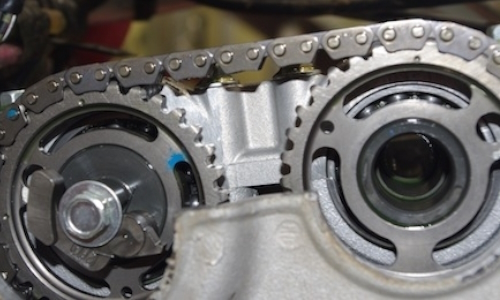
What is a distribution chain?
La distribution chain is an essential part of many engines. Made of metal, it resembles a bicycle chain and has been installed in four-stroke engines since 2000.
The motorcycle timing chain plays a synchronization role between the crankshaft and the camshaft. When the crankshaft begins to rotate to animate the pistons, it at the same time drives the timing chain, which then transmits the movement to the camshaft which thus moves the valves. The opening and closing of the valves is done very precisely par relation to the movement of the pistons. If the chain were to break, the induced desynchronization could cause shocks between the pistons and the valves.
It is in fact a chain of a very particular type inserted into the engine, behind the cylinder heads (you have to open the top of the engine to find it)... That said, as any chain, it shows symptoms of fatigue.
What are the symptoms of wear?
Unusual sounds are a common warning sign that a problem exists inside your engine. Under normal conditions, the engine should have a steady, smooth sound that indicates everything is working as it should. However, when the timing chain is loose it can cause a vibration inside the engine and will be reported par a clicking noise when the engine is idling.
A problem with the timing chain is usually noticeable when the engine is started from cold. A slight clicking sound indicates something is wrong. The noise only lasts a few seconds, so pay attention to it during the next cold start.
The timing chain is cooled par engine oil. Metal abrasion and fine particles are captured par the oil filter. As soon as the timing chain has reached the end of its life, it must be replaced.
All manufacturers recommend replacing the engine oil and filter very regularly. The reason is that, over time, oil begins to separate as it heats up and is exposed to the natural solvents found in gasoline. If the timing chain begins to wear, small pieces of metal may break off the chain and enter the oil pan. When you change your oil and notice that there are small pieces of metal inside the drained oil or in the filter, this is a good indication that your distribution chain is starting to fail.
Pulleys, sliders and chain tensioners are wornar mechanical constraints, the problem with the timing chain is its elongation. Under heavy loads, it stretches in length. This is called timing chain elongation. If the timing chain is longer than intended, it will jump individual teeth in the gear.
One way to check the condition of your motorcycle's timing chain yourself is to open the cylinder head cover and measure the chain. The chain is measured on twenty links and must correspond to the indication given par the RMT (Motorcycle Technical Review). We take the opportunity to look in the engine at the wear of the pads, which can be replaced independently. If the chain rattles, we can also start par Remove the chain tensioner and reset it before putting it back. Often this solves the noise problem.
Why a distribution chain?
The distribution chain has some disadvantages par in relation to the belt:
His weight : heavier, the chain therefore leads to greater fuel consumption and pollution.
Its noise: the steel of the timing chain is noisier when operating than a belt.
His price : in the event of damage or breakage, the timing chain is more expensive than a belt. However, it does not need to be replaced periodically and will ultimately cost you less over the life of the vehicle.
Another difference: the timing chain is permanently bathed in engine oil in a sealed housing. To properly maintain your distribution chain, it is therefore important to ensure its proper lubrication. To do this, you must ensure that you do your oil change at the recommended intervals.ar your manufacturer. Like the belt, the tension of the timing chain is ensured par tensioners. The chain also has shoes which guide it within the engine.

Tip
The lifespan of a chain will be linked to several factors: the use of the motorcycle in the first place (sporty or quiet riding), respect for oil changes, respect for the warm-up time, the maintenance chain resistance.











